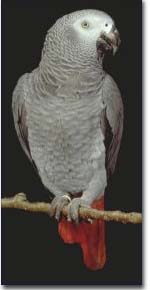
When properly raised, African Grey parrots are outgoing, self-confident birds that can develop excellent vocabularies and can speak very clearly. African Greys also love to precisely imitate strange sounds, such as the key in the lock or the sound of the telephone. Tending to be quieter birds, African Greys appreciate peaceful household environments. They are often quite cuddly and enjoy a good skritching (rubbing the feathers the wrong way on their heads). They have an unusual digging behavior that they sometimes indulge in the bottom of their cage or on any flat surface. They love to play hard with hanging toys, especially heavy-duty bells.
African Grey parrots have "powder down" that generates a fair amount of dust in your home. Therefore, African Greys are not a good choice for people who have sensitive lungs. If they bite, they seldom give a gentle warning nip first. When African Grey parrots are afraid they emit a metallic growling sound.
There are two species of African Grey parrots: Congo African Greys and Timneh African Greys. Each of these species has a distinct personality.
Congo African Grey parrots are the better-known species, with bright red tails, pale gray bodies and all-black beaks. They tend to be very intelligent, emotionally sensitive, and more introverted (thinking) parrots. Congo African Grey parrots tend to be more cautious of new situations and new people than other birds. Most of them can learn to speak very well and can develop huge vocabularies that they use in appropriate contexts.
Timneh African Grey parrots are smaller and darker than Congo Greys, with dark maroon tails and pink in their black beaks. Timneh African Greys are more gregarious and enthusiastic. Like the Congo, they also can develop large vocabularies. Timneh African Greys are a little less emotionally sensitive than Congo Greys, and are more flexible in their approach to life.
Both species of African Grey parrots need a little more calcium in their diets than most other parrots. Each makes a wonderful companion. See our species-specific profiles by selecting individual species at the right of this page.